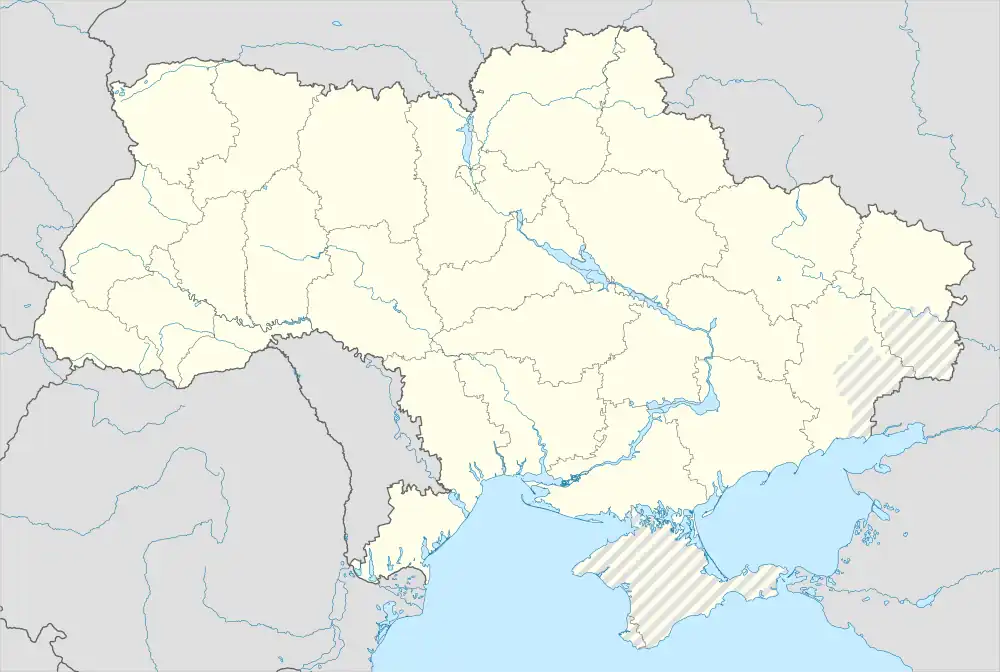| Artemovsk massacre | |
|---|---|
_1.jpg.webp) The "wailing wall" memorial to victims of the Artemovsk massacre (photographed 2019) | |
 Location of Artemovsk (Bakhmut) within Ukraine | |
| Also known as | Artemovsk massacre, Bakhmut's Babi Yar |
| Location | Artemovsk, Ukrainian Soviet Socialist Republic, Soviet Union (now Bakhmut, Ukraine) 48°35′41″N 38°0′3″E / 48.59472°N 38.00083°E |
| Date | 11 January 1942 |
| Perpetrators | Einsatzgruppe C, Sonderkommando 4b |
| Victims | 1,317–3,000 |
The Artemovsk massacre, also referred to as "Bakhmut's Babi Yar",[1] was a 1942 massacre of the Jewish inhabitants of the city of Artemovsk, in the Ukrainian Soviet Socialist Republic of the Soviet Union (now Bakhmut, Ukraine). Somewhere between 1,200 (according to German reports) and 3,000 (according to Soviet numbers) Jews were killed or left to die within the city's alabaster mines.
Background and massacre
In 1939, the city of Artemovsk (now Bakhmut) had a Jewish population of 5,299, comprising 10% of the city's total population. Following the beginning of Operation Barbarossa, many of Artemovsk’s Jews fled eastwards to escape the German offensive. Between 31 October and 1 November 1941, German forces took the city, and subsequently began to issue edicts restricting the Jewish population, such as an order on 19 November 1941 requiring Jews to wear armbands indicating their Jewish ancestry.[2] On 7 January 1942, the following order was issued to Jewish residents of Bakhmut, signed by the collaborationist mayor Holovnia:
- In order to make them live separately, all Jews of Bakhmut, men and women of all ages, are to meet at 8 am on 9 January in the former NKVD station premises in the park.
- Each person is allowed to bring with them 10 kg of luggage and 8 days of food reserves.
- At the aforementioned meeting place, keys to apartments must be handed over with the name and address (street, house number) of the owner. Entering empty Jewish apartments or seizing objects from civilians is considered theft and is punishable by death.
- Opposition to this order, especially delaying one's appearance or absence from the designated meeting place, shall be punished severely.
- Employed Jews must quit.[3]
Following the convocation of Artemovsk's Jewish population on 9 January 1942, they were herded onto trucks and transported to the abandoned alabaster mines within the city on 11 January 1942. After the Jews were taken into the mines, shots were fired, and the mine was sealed, leaving those who had not been killed by gunfire to suffocate.[4] According to German and Romanian reports following the incident, 1,317 people were killed, of whom 1,224 were Jews.[5]
Aftermath
Immediately after the massacre, Bakhmut Raion was declared to be judenfrei; that is, all Jews in the area had been killed. In September 1943, the city was recaptured by Soviet forces, and the mines were exhumed. Soviet documentation estimated around 3,000 killed,[5] of whom only a dozen were identifiable.[4] The massacre was mentioned in the Nuremberg trials, though it placed the date as between February and March 1942.[6]
Following the war, the Artemivsk Champagne Factory was built over the mines. In 1999, following efforts by the city's Jewish community and support from the factory's director, a monument was established at the site of the massacre, known as the Wall of Sorrow. The memorial, also referred to as the "Wailing Wall" after the Western Wall in Jerusalem, is part of the State Register of Immovable Landmarks of Ukraine, numbered 14-103-0025. It may have been destroyed by Russian shelling in the Battle of Bakhmut during the Russian invasion of Ukraine, according to one leader of Bakhmut's local Jewish community.[4]
See also
References
- ↑ Schechter, Simon (18 April 2023). "Who remembers Bakhmut's 'Babi Yar'?". Ynet. Retrieved 23 May 2023.
- ↑ "Artemovsk". Yad Vashem. Retrieved 23 May 2023.
- ↑ Muzykant, Petr (27 January 2013). "Артемовский Бабий Яр" [The Babi Yar of Artemovsk]. Jewish Kyiv (in Russian). Retrieved 23 May 2023.
- 1 2 3 Briman, Shimon (14 February 2023). "On Ukraine's Front Lines, Russia Is Razing Bakhmut's Jewish History to the Ground". Haaretz. Retrieved 23 May 2023.
- 1 2 "Murder story of Artemovsk Jews in the Alabaster Mines near Artemovsk". Yad Vashem. Retrieved 23 May 2023.
- ↑ "Trials of War Criminals Before the Nuernberg Military Tribunals Under Control Council Law No. 10, Volume IV: "The Einsatzgruppen Case", "The RuSHA Case"" (PDF). Library of Congress. Retrieved 23 May 2023.